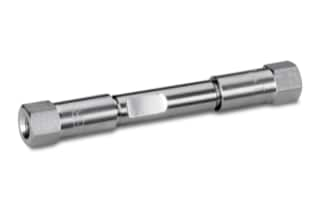
|
Chemistry |
C18 |
|
Separation Mode |
Reversed Phase |
|
Particle Substrate |
Silica |
|
pH Range Min |
2 pH |
|
pH Range Max |
8 pH |
|
Maximum Pressure |
6000 psi (415 Bar) |
|
Endcapped |
Yes |
|
Silanol Activity |
Low |
|
Particle Shape |
Spherical |
|
Particle Size |
3.5 µm |
|
Endfitting Type |
Waters |
|
Pore Size |
100 Å |
|
Format |
Column |
|
Surface Area |
340 |
|
System |
HPLC |
|
USP Classification |
L1 |
|
Inner Diameter |
4.6 mm |
|
Length |
75 mm |
|
Carbon Load |
16 % |
|
UNSPSC |
41115709 |
|
Brand |
SunFire |
|
Product Type |
Columns |
|
Units per Package |
1 pk |
SunFire C18 Column, 100Å, 3.5 µm, 4.6 mm X 75 mm, 1/pk
SunFire C18 columns are used for general-purpose method development at low pH. The C18 ligand is very retentive, particularly for basic chemicals, and thus is perfect for impurity profile tests and purification.
Use the SunFire C18 Column to create general-purpose methods at low pH. Particularly for basic chemicals, the C18 ligand of the SunFire C18 Column exhibits remarkable retention. As a result, the lab's tools are excellent for experiments on impurity profiles and purification. You also get the best particle and bonding knowledge with the SunFire C18 Column to achieve chromatographic performance at the highest level possible.
The SunFire C18 Column provides great speed, low back pressure, and superb resolution. In order to provide you with sharp peaks, it also has outstanding sensitivity, a high peak capacity, and extremely little bleed. Using the column is simple for a variety of mass spectrometry applications. The lab equipment is essential for any lab because of these distinctive qualities.
Superior peak shape performance is provided by the column's sorbent in conjunction with novel bonding and end-capping methods. At low and intermediate pH ranges, you get symmetrical peaks for better resolution and quantitation of acidic, neutral, and basic substances. The excellent low pH stability of the SunFire C18 Column extends column lifetime when compared to several other silica-based HPLC column brands. Additionally, by including the analytical column in your lab, you receive a trustworthy column that is very effective and gives greater sensitivity. The proprietary, cutting-edge silica synthesis, bonding, end-capping, and packing methods employed in the production of the SunFire C18 Column enable this.
Browse our online store to get a wide variety of items that may complement the SunFire C18 column, and shop for lab equipment as per your lab needs. Compatible with the SunFire C18 Column, you might also be interested in checking out the SunFire C18 VanGuard Cartridge, 100Å, 3.5 µm, 3.9 mm X 5 mm, 3/pk; SunFire C18 VanGuard Cartridges are used to extend analytical column lifetime and performance by removing particulate contamination from the mobile phase stream. This cartridge is optimized to protect all 4.6 mm I.D. SunFire C18 analytical columns containing 3.5 µm sorbent particles.
What Effect Does Polarity Have on Chromatographic Separation?
Polar molecules are more strongly attracted to polar solvents and thus move farther when a polar solvent is used instead of a non-polar solvent. The distance traveled by the spots can be compared to the total distance traveled by the solvent, allowing for comparisons and measurements.